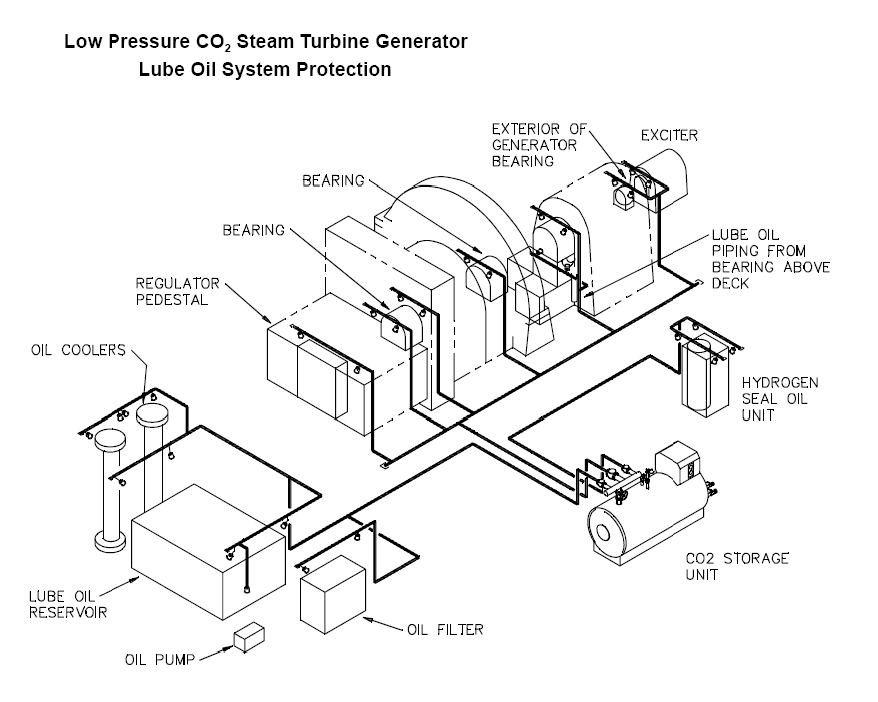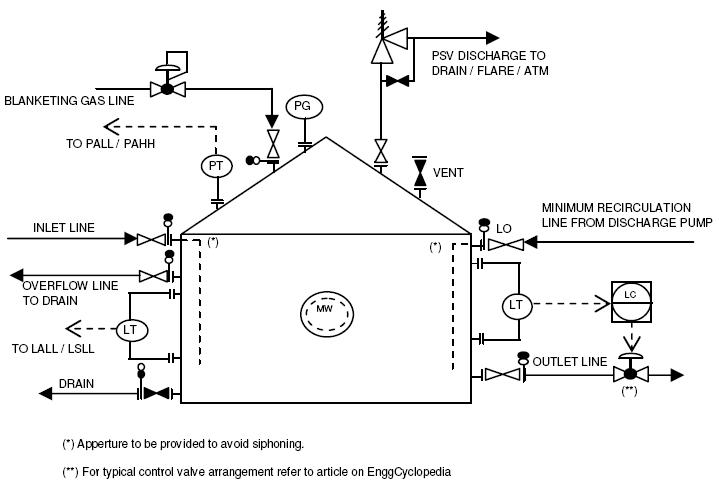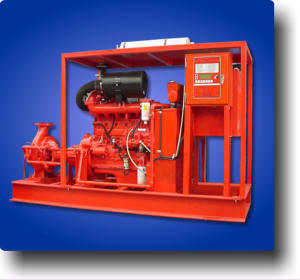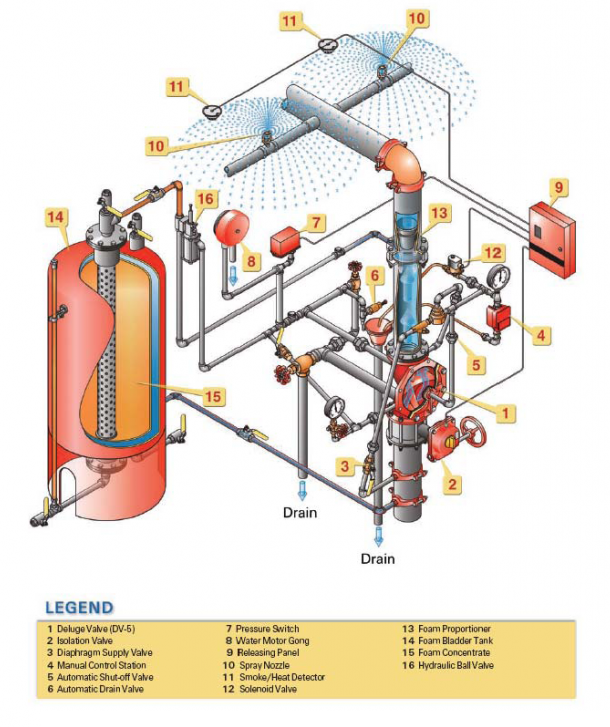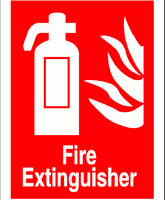NFPA 850 provides recommendations (not requirements) for fire protection for fossil fueled (i.e. coal, gas or oil) or alternative fueled (i.e. biomass, solid waste etc) power generation plants.
Nuclear power plants or hydroelectric power plants are not covered by NFPA 850: Nuclear power plants standards are addressed by NFPA 805, whereas recommendations for hydroelectric power plants are presented at NFPA 851.
Firstly, a fire risk control program should be put in place, which should be reviewed and updated periodically. As a minimum, written procedures shall be prepared for the following:
- Detailed fire prevention program,
- Detailed impairments procedure, for identifying and rectifying equipment not available for service,
- Fire emergency plan.
Recommendations for fire protection for power plant
A fire area determination should be carried out in the first place. Fire area boundaries should be created in order to separate critical areas like cable spreading rooms-tunnels, control rooms, computer rooms, switchgear rooms, battery rooms, warehouses, fuel oil facilities and boilers, fuel tanks -containers etc. from adjacent areas. In accordance with NFPA 850, fire barriers separating fire areas should have a 2-hour fire resistance rating as a minimum.
Fire protection for oil-insulated outdoor type transformers
It is strongly recommended that any oil-insulated outdoor type transformer containing 500 gal (1890 liters) or more of oil is separated from nearby structures by a 2-hour–rated firewall or by specific spatial separation in accordance with NFPA 850 recommendations.
Wherever a firewall is installed between transformers (please refer to the picture below), it should extend at least 1 ft (0.31 m) above the top of the transformer shell and oil tank and at least 2 ft (0.61 m) beyond the width of the transformer and cooling radiators.
Fire protection for indoor transformers
Dry-type transformers are strongly preferred for use inside buildings. In case however, an oil-insulated transformer is installed indoors, then if its oil content exceeds 100 gal (379 liters), then it should beseparated from nearby areas by a fire barrier of 3-hour fire resistance rating. In case an automatic fire extinguishment system is installed, then it is allowed that the fire restistance rating of the fire barrier is reduced to 1 hour.
Construction materials for power plants
With the exception of roof materials, materials used in critical buildings of the power block shall be either non combustible or limited combustible. Roof covering is recommended to be be Class A, in compliance with NFPA 256, whereas metal roof deck construction, should be either “Class I” or “fire classified.”
HVAC systems, smoke and heat vent systems
HVAC systems and all related components (fire dampers, ducts etc) shall generally be designed in compliance with NFPA 90A and NFPA 90B standards.
Air conditioning for the control room needs to provide a slightly pressurized environment so as to avoid the ingress thof smoke in the event of a fire outbreak outside the control room.
Smoke and heat vent systems do not replace normal ventilation systems. Smoke and heat vents need to be installed in areas specified by the fire risk evaluation and designed in accordance with NFPA 92A and NFPA 204 standards.
Water supply for fire protection
Fire pumps and fire tanks will have to be sized for a period of 2 hours water supply so as to meet the following requirements:
- the biggest fixed fire extinguishment system demand (it is calculated from the detailed fire fighting study) or any fixed fire suppression system demands that are expected to operate simultaneously during a single event, whichever is bigger and
- a hose stream supply not less than 500 gpm (1890 liters/minute)
In case tanks are used for fire fighting water supply, they need to be filled from a source capable of recovering the 2-hour supply in maximum 8 hours. It is strongly recommended that tanks refilling is carried out automatically.
Fire protection for oil fueled plants
Fuel oil handling facilities shall generally comply with NFPA 30, NFPA 31 and NFPA 70 standards.
Internal tank heaters should be equipped with temperature sensing devices for alarm initiation in case of tank content overheating. External tank heaters should be interlocked with a flow switch to isolate the heater if oil
flow is interrupted. For safety purposes, pumps shall be installed outside of the tanks dikes and close monitoring of tanks filling shall be mandatory in order to avoid tank overfilling.
Depending on the case, automatic systems, either with water, foam-water or gaseous flooding systems (please refer to picture below) can be used for fire protection purposes. Use of foam systems for outdoor storage tank protection should be stongly considered in the fire risk evaluation.
Fire protection for coal powered plants
Coal piles are very prone to fire initiation due to the spontaneous self-heating of the coal. In general, short-term storage piles have to be kept. Dead pockets of coal must be avoided.
Coal piles must not be located in close vicinity to sources of heat, such as steam lines, or sources of air, such as manholes, doors etc.
Storage structures (silos, bunkers etc) should be of noncombustible materials and designed with the minimum number of corners, horizontal surfaces, or pockets that cause coal to remain trapped and thereby increase the risk for spontaneous combustion.
Since coal dust also constitutes a fire hazard, properly designed dust collection or dust suppression systems shall be installed in order to minimise coal dust dispersion.
Coal conveyor belts should be of material designed to resist ignition. Hydraulic systems should only use listed fire-retardant hydraulic fluids.
Automatic sprinkler or water spray systems should be employed for fire protection of coal handling structures that are critical to power generation where coal or coal dust is likely to be accumulated.
Fire protection to pulverizers
Design shall be in accordance with NFPA 85. Use of carbon monoxide gas detection systems is strongly recommended as an early indication of conditions which could lead to fire initiation or even explosion.
Fire protection to turbine generators
In case the generator is hydrogen-cooled, NFPA 55 standard will have to be respected. Routing of hydrogen piping shoud avoid hazardous areas. Redundant hydrogen seal oil pumps with separate power supplies should be provided.
Hydraulic control system as well as lube oil systems shall use a listed fire-resistant fluid. Lube oil reservoirs-tanks should be provided with a vapor extractor, vented to a safe location outside of the turbine building. Lube oil system components shall comply with NFPA 30 standard.
All areas beneath the turbine-generator operating floor where oil flow, oil spray, or oil accumulation could occur should be protected by an automatic sprinkler or foam-water sprinkler system.
Turbine-generator bearings should be protected with an automatic closed-head sprinkler system.
Turbine generator exciter housing should be protected with a total flooding automatic carbon dioxide system.
For more details on equipment briefly described above but also for other equipment like scrubbers, electrostatic precipitators, cable tunnels, boiler feedwater pumps etc , the user is kindly requested to consult NFPA 850.

